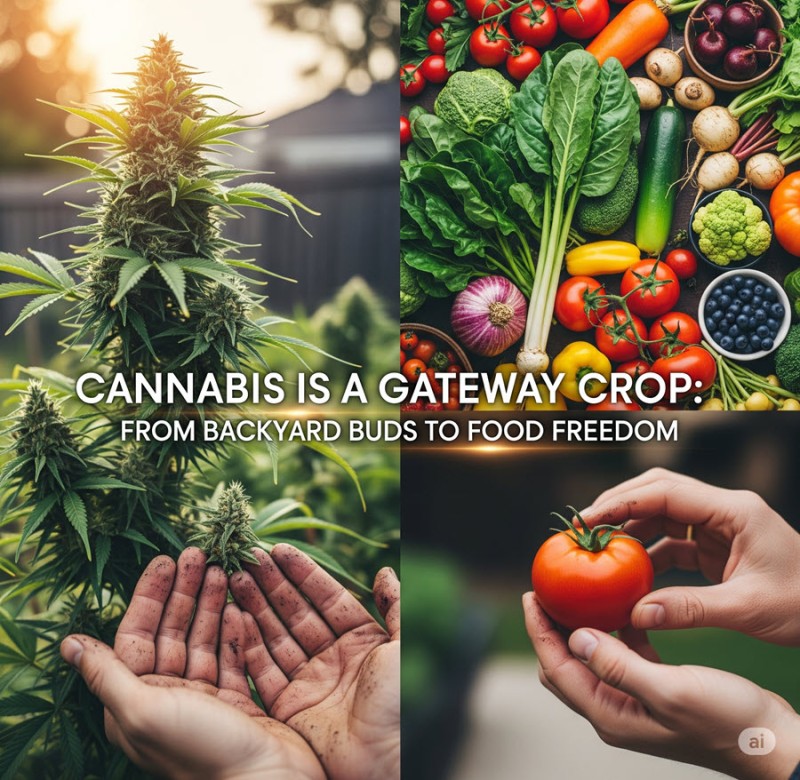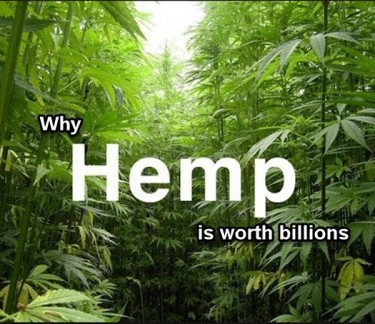
There's an old saying among cannabis cultivators: "Cannabis isn't addictive, growing it is." As someone who's cropped out several times over the years, I can attest to the profound truth in those words. But recent polling data reveals an even more fascinating phenomenon - cannabis is proving to be a "gateway crop" that's inspiring millions of Americans to rediscover the lost art of growing their own food and medicine.
A new survey of 1,327 home cannabis cultivators found that two-thirds say growing marijuana inspired them to start growing tomatoes, with nearly a quarter admitting they never grew tomatoes until years after cultivating their first cannabis plant. Following tomatoes, the top crops people were inspired to grow included basil, strawberries, chili peppers, cucumbers, and lettuce. As Jessica Hanson from Homegrown Cannabis Co. put it: "Cannabis isn't a gateway drug, it's a gateway crop. Before you know it, you've got a backyard full of tomatoes, and maybe even a few zucchinis."
This agricultural awakening couldn't come at a better time. We're living through an era that bears eerie similarities to the conditions preceding the Great Depression - skyrocketing food prices, wealth inequality reaching historic levels, supply chain vulnerabilities, and increasing dependence on corporate food systems that prioritize profits over nutrition. The average American family now spends over 15% of their income on food, compared to just 8% in the 1960s, while the nutritional quality of mass-produced food continues to decline.
Cannabis cultivation is teaching people skills they didn't know they needed: patience, attention to detail, understanding of plant biology, soil management, pest control, and the deep satisfaction that comes from nurturing life from seed to harvest. Once someone experiences the joy of smoking their own homegrown cannabis - knowing exactly how it was grown, what went into the soil, and having complete control over the process - they inevitably start wondering what else they could grow.
The timing is perfect for an agricultural revolution driven by cannabis cultivators who are discovering that the same skills that produce quality cannabis can feed their families, reduce grocery bills, and provide food security in an increasingly uncertain world.
The Great Depression Parallels: Why Growing Food Matters Now
The similarities between our current economic situation and the conditions that preceded the Great Depression are striking and should concern anyone paying attention to food prices and supply chain vulnerabilities. In the 1920s, wealth inequality reached historic levels with the top 1% controlling nearly 25% of the nation's wealth - almost identical to today's concentration. Credit expansion and speculative bubbles characterized both eras, with people taking on unprecedented debt levels while asset prices soared beyond sustainable levels.
During the 1930s and 1940s, most American families grew significant portions of their own food out of necessity. Victory gardens during World War II produced 40% of the nation's vegetables, demonstrating that decentralized food production could feed the country more effectively than corporate agriculture. But the post-war introduction of supermarkets and industrial farming gradually convinced Americans to abandon food production in favor of convenience and consumption.
Today's food system represents a massive vulnerability that most people don't recognize until prices spike or supply chains break down. The average piece of food travels 1,500 miles from farm to plate, passing through multiple corporate intermediaries who add costs while removing nutrients. A handful of corporations control most food production, processing, and distribution, creating single points of failure that can disrupt entire regions' food supplies.
The recent inflation in food prices - with some staples increasing 30-50% in just two years - has awakened many Americans to their vulnerability within this corporate-controlled food system. Meanwhile, the nutritional quality of commercial produce continues declining as industrial agriculture prioritizes appearance, shelf life, and transport durability over vitamins, minerals, and flavor.
Cannabis cultivators are uniquely positioned to lead a food production renaissance because they already possess the skills, equipment, and mindset necessary for successful agriculture. Growing cannabis teaches plant biology, nutrient management, environmental control, pest identification, harvest timing, and curing processes - all directly transferable to food production.
More importantly, cannabis cultivation develops the psychological relationship with plants and soil that industrial society has largely abandoned. When you've experienced the satisfaction of producing your own medicine, the idea of producing your own food becomes not just appealing but essential for true independence.
From Grow Tents to Garden Beds: Practical Applications
The transition from cannabis cultivation to food production is remarkably seamless because both require similar skills, equipment, and attention to detail. Cannabis growers already understand concepts like nutrient cycling, pH management, lighting requirements, air circulation, and integrated pest management - knowledge that directly applies to growing vegetables, herbs, and fruits.
Hydroponic systems designed for cannabis work excellently for lettuce, herbs, tomatoes, peppers, and other crops that thrive in controlled environments. The same grow tents, LED lights, ventilation fans, and nutrient delivery systems can produce food year-round regardless of climate or season. Indoor cannabis cultivators often discover they can grow fresh vegetables through winter months when outdoor gardening becomes impossible.
The attention to detail that cannabis cultivation demands - monitoring pH levels, adjusting nutrients, controlling humidity, managing light cycles - translates directly to producing higher-quality food than anything available in supermarkets. When you apply cannabis-growing precision to tomatoes, the results are spectacular: fuller flavor, higher nutrition, and varieties unavailable commercially.
Equipment overlap makes the transition economically sensible. Grow lights, ventilation systems, timers, pH meters, nutrient solutions, and environmental controls serve both cannabis and food production. Someone with a complete cannabis setup already owns most of what's needed for serious food production.
Space efficiency techniques developed for cannabis - like Sea of Green, Screen of Green, and vertical growing - work brilliantly for maximizing food production in limited spaces. Urban cannabis cultivators can apply these methods to produce surprising amounts of food in apartments, basements, or small outdoor spaces.
Container gardening techniques used for discrete cannabis cultivation adapt perfectly to food production. The same trash cans, storage totes, and fabric pots that hide cannabis plants can grow potatoes, carrots, lettuce, and other staples in spaces where traditional gardening isn't possible.
The seasonal rhythm of cannabis cultivation - planning, germination, vegetative growth, flowering, harvest, curing - mirrors food production cycles and teaches the patience and long-term thinking necessary for agricultural success. Cannabis growers understand that quality results require time and attention rather than instant gratification.
Beyond Vegetables: The Homesteading Progression
Once cannabis cultivators experience the satisfaction of growing food, many discover they want to expand further into livestock, fruit trees, medicinal herbs, and other aspects of homesteading that provide greater self-sufficiency and food security. The progression from cannabis cultivation to comprehensive homesteading represents a natural evolution of the skills, mindset, and independence that growing teaches.
Chickens represent a logical next step for many cannabis-turned-food growers because they're relatively easy to manage, provide fresh eggs daily, help with pest control, and produce excellent fertilizer for gardens. Ducks offer similar benefits while being hardier and better foragers, making them excellent for integrated garden systems.
Goats provide milk, cheese, meat, and land clearing services while being easier to manage than cattle and requiring less space. They're particularly valuable for homesteaders in areas with brush or rough terrain that needs clearing for cultivation.
Fruit trees and berry bushes require minimal maintenance once established but provide years of production from a single investment. Cannabis growers understand the patience required for long-term agricultural investments and often appreciate perennial crops that complement annual gardens.
Medicinal herb cultivation represents another natural progression for cannabis growers interested in plant medicine and herbal remedies. Many therapeutic herbs require similar growing conditions and attention to harvest timing and curing processes that cannabis cultivators already understand.
Bee keeping provides pollination services for gardens while producing honey, wax, and other valuable products. Cannabis cultivators often appreciate bees' role in ecosystem health and understand the importance of supporting pollinators.
The preserved food production - canning, dehydrating, fermenting - that homesteading requires builds on the curing and storage skills that cannabis cultivation teaches. Understanding how to properly cure cannabis translates directly to food preservation techniques.
Water management, composting, soil building, and other homesteading skills represent advanced applications of principles that cannabis cultivation introduces. The same attention to soil biology, nutrient cycling, and environmental management applies whether growing cannabis or creating sustainable food systems.
The Sticky Bottom Line: Growing Your Way to Freedom
The revelation that cannabis cultivation serves as a gateway crop to broader agricultural engagement represents more than just an interesting polling result - it demonstrates how growing plants reconnects people with fundamental skills for independence and self-sufficiency that corporate food systems have systematically eroded.
In an era of increasing food prices, supply chain vulnerabilities, and declining nutritional quality in commercial products, the ability to produce your own food represents both economic security and health insurance. Cannabis cultivators are uniquely positioned to lead this agricultural renaissance because they already possess the skills, equipment, and mindset necessary for successful food production.
The transition from growing cannabis to growing food isn't just about saving money on groceries - though the economics are compelling. It's about reclaiming control over what you consume, understanding where your food comes from, and developing the self-reliance that previous generations took for granted.
Whether you start with herbs in windowsill containers, vegetables in grow tents, or ambitious outdoor gardens, the important thing is starting. The same attention to detail that produces quality cannabis will produce exceptional food that surpasses anything available commercially.
As economic uncertainty increases and food prices continue rising, the ability to produce your own sustenance becomes increasingly valuable. Cannabis cultivation teaches all the necessary skills while providing medicine that makes the work more enjoyable and the results more satisfying.
The gateway crop phenomenon reveals something profound about human nature: once people experience the satisfaction of growing their own medicine, they naturally want to grow their own food. Cannabis doesn't just heal bodies - it heals the relationship between people and plants that industrial society has severed.
So whether you're already growing cannabis or considering starting, remember that you're not just cultivating a plant - you're developing skills that could feed your family, reduce your expenses, and provide security in uncertain times. Cannabis may be the gateway crop, but food security is the destination.
Start with what interests you most. Perfect your techniques. Then expand. Before you know it, you'll be eating salads from your garden and wondering why you ever thought supermarket vegetables were acceptable.
The revolution starts in the soil, one plant at a time.
HEMP OR CANNABIS AS A CROP, READ ON...
IS THE HEMP MARKET WORTH BILLIONS MORE THAN THE WEED MARKET?







